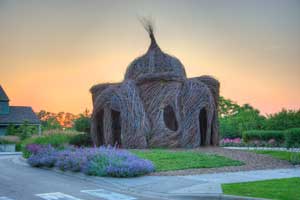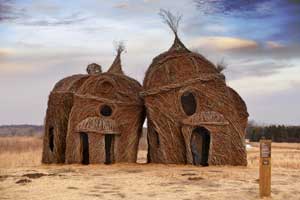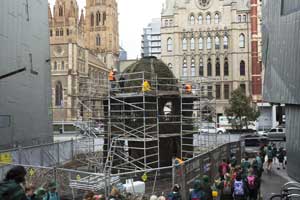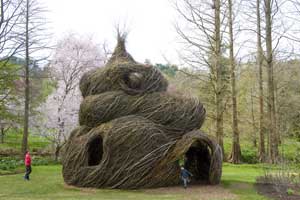

While Patrick Dougherty says he “works with wood constantly, I usually think of it as a sapling, or as a line with which to draw.”
His work, drawn from a combination of graduate studies in sculpture and an interest in wood as a material, focuses on large-scale structures built from sticks.
“Sticks are the kind of things that adjust” to a variety of uses, Patrick said, noting how children can make out of them a magic wand, a sword, and other items. When massed together, “Sticks tangle all up, and that infuriating tendency is what I use to hold things together,” Patrick said.

Each of his structures – he’s built about 250 of them, averaging around 10 a year since the early 1980s – begins with a site visit, then a three-day process of gathering materials. “I think about the site I’ve been given, and what kind of excitement I could garner for it. Sometimes the community needs something more literal, and sometimes it’s more abstract,” Patrick said.

Since he’s often working in public places, members of the community also become part of the project. “You know how people like watching a house get built,” he said, comparing that type of fascination to onlookers of his projects, some of whom become regulars as they cross paths daily. “I like the disbelief that’s part of the initial dumping of sticks on the ground,” he said.
For some of his larger pieces, he will start with a structural base formed from a hole dug in the ground and filled with larger saplings, almost as big as small trees. At other times, he’ll use features on a tree or a building as attachments. And, occasionally, he’s built a metal base into which he’s dropped sticks.

“When I first start, I put the structural pieces in the ground, as a kind of crust. The second phase is a kind of ‘appliqueing,’ when I put things where I think they look good; it’s loosely what we think of as weaving. The last bit is cosmetic, getting rid of hanging edges.”
His materials depend on the types of wood available in the area where he’s working. In his current project in Michigan, he’s using willow. A project in Nashville, Tennessee used ash and privet. “Maples are a favorite,” Patrick said. “Ash is a dry wood, but still is very flexible. A lot of woods are not very flexible: hickory is hard, and it doesn’t make that many saplings.”
He also likes maple because it holds its color; some woods, such as red-twigged dogwood, notes Patrick, can fade in color, becoming more black.

“I know a lot about one aspect of many woods, and that’s how well they bend,” he said. “I’ll flex the stick and put it in” his structure. “It’s arranging them then, and catching them on the upper limbs. Then I’ll bend it and drive it through the structure, and back down.”
“There’s no nails or wires or strings holding things together,” Patrick said, and also noted, “I rarely do much cutting of wood.”
Basically, the only tools he uses are a hand saw or pruning saw, and a set of Felco® gardening clippers, Patrick said.
While he has used a carpentry background to build his own log cabin, and occasionally has trees milled at his North Carolina home to be used for “thousands of things” in his personal life, Patrick’s stick sculptures – other than an installation at the North Carolina Museum of Art – are meant to be impermanent.
“They’re meant to last for about two years,” he said. “One great year, and one pretty good year.”

During that time, although Patrick does take into account location when he places his sculptures, “People use these spaces, too. They have to be pretty tough to stand up to the wear and tear of people walking by and through them, and to stand up to the snow load and the wind that may be part of that community.”





